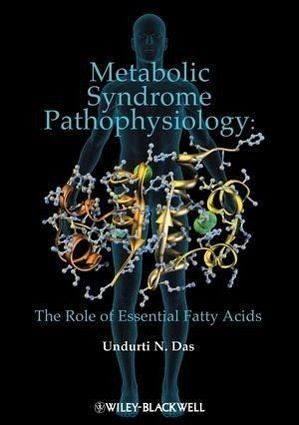
Metabolic Syndrome Pathophysiology
The Role of Essential Fatty Acids

PAYBACK Punkte
167 °P sammeln!
Metabolic Syndrome Pathophysiology: The Role of Essential Fatty AcidsMetabolic Syndrome Pathophysiology: The Role of Essential Fatty Acids provides current research exploring the links among insulin, insulin receptors, polyunsaturated fatty acids, brain growth and disease. Specific interactions of essential fatty acids and polyunsaturated fatty acids in brain development and several disease groups are described. The role of inflammation in disease and how fatty acids regulate low-systemic inflammation are examined and explained. Metabolic and neurologic dynamics are presented to provide a link...
Metabolic Syndrome Pathophysiology: The Role of Essential Fatty Acids
Metabolic Syndrome Pathophysiology: The Role of Essential Fatty Acids provides current research exploring the links among insulin, insulin receptors, polyunsaturated fatty acids, brain growth and disease. Specific interactions of essential fatty acids and polyunsaturated fatty acids in brain development and several disease groups are described. The role of inflammation in disease and how fatty acids regulate low-systemic inflammation are examined and explained. Metabolic and neurologic dynamics are presented to provide a linkage between the presence of omega-3 and omega-6 and protection against diseases and conditions such as diabetes mellitus, obesity, autoimmune diseases and hypertension.
Preliminary chapters provide an overview of the history and diagnosis of metabolic syndrome and its link to insulin resistance. Following chapters cover obesity, hypertension and diabetes, and remaining chapters provide detailed information on the role and physiology of essential fatty acids.
This book is a key reference for nutrition researchers and clinical nutritionists working in the areas of lipids and metabolism, metabolic syndrome, obesity, hypertension and diabetes.
Comprehensively reviews current research on metabolic diseases
Discusses molecular aspects of biochemistry, physiology, and pathology of metabolism of essential fatty acids
Includes chapters devoted to obesity, hypertension, heart disease and certain cancers Metabolic Syndrome Pathophysiology: The Role of Essential Fatty Acids provides current research exploring the links among insulin, insulin receptors, polyunsaturated fatty acids, brain growth and disease. Specific interactions of essential fatty acids and polyunsaturated fatty acids in brain development and several disease groups are described. The role of inflammation in disease and how fatty acids regulate low-systemic inflammation are examined and explained. Metabolic and neurologic dynamics are presented to provide a linkage between the presence of omega-3 and omega-6 and protection against diseases and conditions such as diabetes mellitus, obesity, autoimmune diseases and hypertension.
Metabolic Syndrome Pathophysiology: The Role of Essential Fatty Acids provides current research exploring the links among insulin, insulin receptors, polyunsaturated fatty acids, brain growth and disease. Specific interactions of essential fatty acids and polyunsaturated fatty acids in brain development and several disease groups are described. The role of inflammation in disease and how fatty acids regulate low-systemic inflammation are examined and explained. Metabolic and neurologic dynamics are presented to provide a linkage between the presence of omega-3 and omega-6 and protection against diseases and conditions such as diabetes mellitus, obesity, autoimmune diseases and hypertension.
Preliminary chapters provide an overview of the history and diagnosis of metabolic syndrome and its link to insulin resistance. Following chapters cover obesity, hypertension and diabetes, and remaining chapters provide detailed information on the role and physiology of essential fatty acids.
This book is a key reference for nutrition researchers and clinical nutritionists working in the areas of lipids and metabolism, metabolic syndrome, obesity, hypertension and diabetes.
Comprehensively reviews current research on metabolic diseases
Discusses molecular aspects of biochemistry, physiology, and pathology of metabolism of essential fatty acids
Includes chapters devoted to obesity, hypertension, heart disease and certain cancers Metabolic Syndrome Pathophysiology: The Role of Essential Fatty Acids provides current research exploring the links among insulin, insulin receptors, polyunsaturated fatty acids, brain growth and disease. Specific interactions of essential fatty acids and polyunsaturated fatty acids in brain development and several disease groups are described. The role of inflammation in disease and how fatty acids regulate low-systemic inflammation are examined and explained. Metabolic and neurologic dynamics are presented to provide a linkage between the presence of omega-3 and omega-6 and protection against diseases and conditions such as diabetes mellitus, obesity, autoimmune diseases and hypertension.












